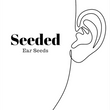In the ever-evolving landscape of skincare, beauty enthusiasts are constantly seeking innovative methods to enhance their natural radiance. One such age-old technique gaining renewed attention is facial cupping. Originating from ancient Chinese, Egyptian, and Middle Eastern cultures, facial cupping has transcended time to become a holistic approach to achieving a youthful, glowing complexion. In this blog, we'll delve into the rich history of facial cupping, explore the best techniques, understand the nuances between small and large cups, discuss frequency, and compare cupping to the popular practice of gua sha.
The Rich Tapestry of Facial Cupping History:
Facial cupping traces its roots back thousands of years, with evidence of its practice found in traditional Chinese medicine, ancient Egyptian beauty rituals, and Middle Eastern cultures. Initially used for therapeutic purposes, cupping was believed to improve blood circulation, release toxins, and stimulate the body's natural healing processes. Over time, this technique found its way into the realm of beauty, promising not just health benefits but also a radiant and youthful complexion.
Best Techniques for the Face:
Facial cupping involves using small suction cups to gently lift the skin and stimulate blood flow, promoting collagen production and reducing tension. To achieve optimal results, it's crucial to master the art of cupping techniques. Professionals recommend applying facial oil or serum to create a smooth glide and using light suction to avoid bruising or discomfort. Circular motions and specific patterns, like following the lymphatic system, contribute to a more effective and enjoyable experience.
Small vs. Large Cups: Navigating the Face and Eyes:

When it comes to facial cupping, size matters – but in different ways. Small cups are ideal for delicate areas like the eyes and lips. They provide precise control and can target fine lines and wrinkles with finesse. On the other hand, larger cups are better suited for broad areas like the cheeks and forehead, allowing for a comprehensive treatment that covers more surface area. Combining both sizes in a session ensures a well-rounded facial cupping experience.

How Often Should You Cup?
The frequency of facial cupping sessions depends on individual preferences and skin needs. However, most experts recommend starting once a week and gradually increasing to 2-3 times a week for optimal results. Consistency is key, and over time, the cumulative effects of increased blood circulation and collagen production contribute to a rejuvenated complexion.
Comparing Cupping to Gua Sha:
While both facial cupping and gua sha share the goal of promoting circulation and natural healing, they differ in their approaches. Gua sha involves scraping the skin with a smooth-edged tool, promoting lymphatic drainage and reducing muscle tension. Facial cupping, on the other hand, relies on suction to lift and stimulate the skin. Both techniques can complement each other, and individuals often find success in incorporating both into their skincare routines for a holistic approach to facial rejuvenation.
Facial cupping, with its roots deeply embedded in ancient traditions, offers a unique and effective path to achieving radiant and youthful skin. By understanding the history, mastering the techniques, and tailoring the practice to individual needs, enthusiasts can unlock the full potential of this rejuvenating art. Whether opting for small cups to delicately target specific areas or embracing the broader coverage of larger cups, the journey of facial cupping promises a timeless fusion of tradition and modern skincare innovation. So, dive into the world of facial cupping with Seeded Ear Seeds and unveil the ancient beauty secret that transcends time.

